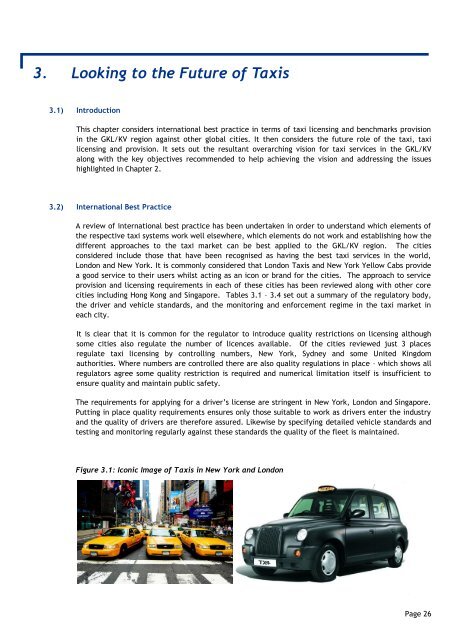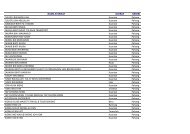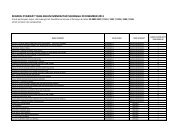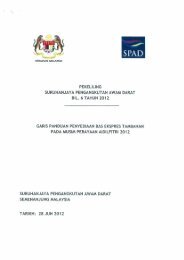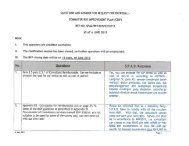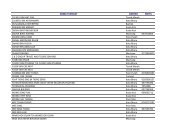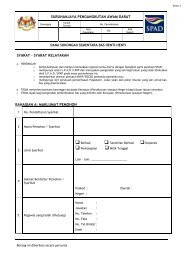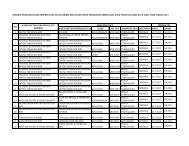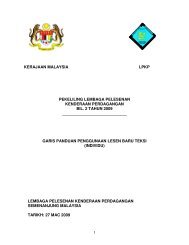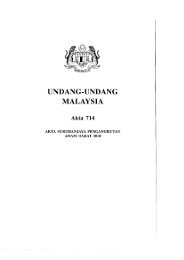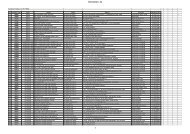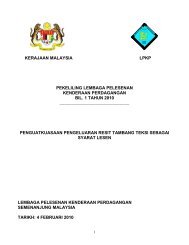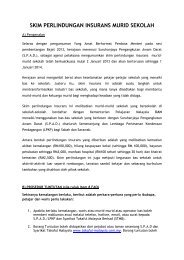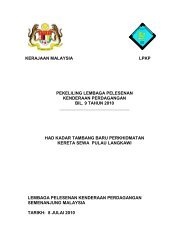4. Developing the Taxi Transformation Plan - SPAD
4. Developing the Taxi Transformation Plan - SPAD
4. Developing the Taxi Transformation Plan - SPAD
You also want an ePaper? Increase the reach of your titles
YUMPU automatically turns print PDFs into web optimized ePapers that Google loves.
3. Looking to <strong>the</strong> Future of <strong>Taxi</strong>s<br />
3.1) Introduction<br />
This chapter considers international best practice in terms of taxi licensing and benchmarks provision<br />
in <strong>the</strong> GKL/KV region against o<strong>the</strong>r global cities. It <strong>the</strong>n considers <strong>the</strong> future role of <strong>the</strong> taxi, taxi<br />
licensing and provision. It sets out <strong>the</strong> resultant overarching vision for taxi services in <strong>the</strong> GKL/KV<br />
along with <strong>the</strong> key objectives recommended to help achieving <strong>the</strong> vision and addressing <strong>the</strong> issues<br />
highlighted in Chapter 2.<br />
3.2) International Best Practice<br />
A review of international best practice has been undertaken in order to understand which elements of<br />
<strong>the</strong> respective taxi systems work well elsewhere, which elements do not work and establishing how <strong>the</strong><br />
different approaches to <strong>the</strong> taxi market can be best applied to <strong>the</strong> GKL/KV region. The cities<br />
considered include those that have been recognised as having <strong>the</strong> best taxi services in <strong>the</strong> world,<br />
London and New York. It is commonly considered that London <strong>Taxi</strong>s and New York Yellow Cabs provide<br />
a good service to <strong>the</strong>ir users whilst acting as an icon or brand for <strong>the</strong> cities. The approach to service<br />
provision and licensing requirements in each of <strong>the</strong>se cities has been reviewed along with o<strong>the</strong>r core<br />
cities including Hong Kong and Singapore. Tables 3.1 – 3.4 set out a summary of <strong>the</strong> regulatory body,<br />
<strong>the</strong> driver and vehicle standards, and <strong>the</strong> monitoring and enforcement regime in <strong>the</strong> taxi market in<br />
each city.<br />
It is clear that it is common for <strong>the</strong> regulator to introduce quality restrictions on licensing although<br />
some cities also regulate <strong>the</strong> number of licences available. Of <strong>the</strong> cities reviewed just 3 places<br />
regulate taxi licensing by controlling numbers, New York, Sydney and some United Kingdom<br />
authorities. Where numbers are controlled <strong>the</strong>re are also quality regulations in place – which shows all<br />
regulators agree some quality restriction is required and numerical limitation itself is insufficient to<br />
ensure quality and maintain public safety.<br />
The requirements for applying for a driver‟s license are stringent in New York, London and Singapore.<br />
Putting in place quality requirements ensures only those suitable to work as drivers enter <strong>the</strong> industry<br />
and <strong>the</strong> quality of drivers are <strong>the</strong>refore assured. Likewise by specifying detailed vehicle standards and<br />
testing and monitoring regularly against <strong>the</strong>se standards <strong>the</strong> quality of <strong>the</strong> fleet is maintained.<br />
Figure 3.1: Iconic Image of <strong>Taxi</strong>s in New York and London<br />
Page 26


